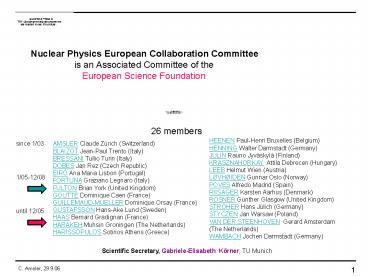Nuclear Physics European Collaboration Committee PowerPoint PPT Presentation
1 / 11
Title: Nuclear Physics European Collaboration Committee
1
Nuclear Physics European Collaboration Committee
is an Associated Committee of
the European Science
Foundation
26 members
HEENEN Paul-Henri Bruxelles (Belgium)
HENNING Walter Darmstadt (Germany) JULIN
Rauno Jyväskylä (Finland) KRASZNAHORKAY
Attila Debrecen (Hungary) LEEB Helmut Wien
(Austria) LØVHØIDEN Gunnar Oslo (Norway)
POVES Alfredo Madrid (Spain) RIISAGER
Karsten Aarhus (Denmark) ROSNER Günther
Glasgow (United Kingdom) STRÖHER Hans Jülich
(Germany) STYCZEN Jan Warsaw (Poland)
VAN DER STEENHOVEN Gerard Amsterdam (The
Netherlands) WAMBACH Jochen Darmstadt
(Germany)
AMSLER Claude Zürich (Switzerland) BLAIZOT
Jean-Paul Trento (Italy) BRESSANI Tullio
Turin (Italy) DOBES Jan Rez (Czech Republic)
EIRÓ Ana Maria Lisbon (Portugal) FORTUNA
Graziano Legnaro (Italy) FULTON Brian York
(United Kingdom) GOUTTE Dominique Caen
(France) GUILLEMAUD-MUELLER Dominique Orsay
(France) GUSTAFSSON Hans-Ake Lund (Sweden)
HAAS Bernard Gradignan (France)
HARAKEH Muhsin Groningen (The Netherlands)
HARISSOPULOS Sotirios Athens (Greece)
since 1/03
1/05-12/08
until 12/05
Scientific Secretary, Gabriele-Elisabeth Körner,
TU Munich
2
( Romania in 2005)
3
Objective of NuPECC
Strengthen European Collaboration in nuclear
science through the promotion of nuclear physics
and its trans-disciplinary use and application
in collaborative ventures between research groups
within Europe and particularly those from
countries linked to the ESF.
- In pursuing this objective the Committee shall
- define a network of complementary facilities
within Europe and - encourage optimisation of their usage
- provide a forum for the discussion of the
provision of - future facilities and instrumentation
- provide advice and make recommendations to the
ESF and to other - bodies on the development, organisation, and
support of European - nuclear research and of particular projects.
- The ESF Executive Council shall periodically -
every five years - at the latest - initiate a review of the work of
the Committee and - its association with the ESF (last review in 2003)
4
Members (1 -3/country) are elected by ESF on
recommendation of the funding agencies, terms 3
3 years (renewable)
Budget 2005 Programme Coordination 64000
(Honoraria, Secretariat) Meetings (3/yr) 8000
Science Meetings 25000 Publications 50000
(Nucl. Phys. News, PANS) Administration 12000
Total 159000 Contribution from CH-SNF
about 6000.- CHF/yr
Suppoted by member organisations of the ESF
involved in nuclear science and research or
research facilities
5
Fields relevant to NuPECC
and relevance to CH
- Not always clear, look at long range plan 2004
- Contents (blue strong activities in CH), e.g.
- QCD ChPT (BE), lattice, structure of the
proton, hadron spectroscopy (ZH, BS) - Phases of nuclear matter
- Nuclear structure
- Nuclear astrophysics (BS), dark matter (ETHZ,
ZH) - Fundamental interactions n oscillations (NE,
GE, BE), 2b decay (NE) - rare decays (PSI), conservation laws, cold
neutrons (PSI) - applications of nuclear science (e.g. nuclear
medicine, atomic mass spectroscopy)
CH community (Summer 2005, PhDs only) mailing
list 12 BS 7 BE 8 ETHZ Total gt 62 6
GE 21 PSI 6 ZH 2 NE
6
NuPECC Publications
- see http//www.nupecc.org
- Nuclear Physics News (4 issues a year)
- NuPECC Roadmap for Construction of Nuclear
Physics - Research Infrastructures in Europe (2005)
- NuPECC Handbook "International Access to Nuclear
- Physics Facilities in Europe" (5th Edition,
2004) - NuPECC Report "NuPECC Long Range Plan 2004
- Perspectives for Nuclear Physics Research in
Europe in the - Coming Decade and Beyond" (2004)
7
Recommendations
6 expert groups from Quantum Chromodynamics
(QCD), Phases of Nuclear Matter, Nuclear
Structure, Nuclei in the Universe,
Fundamental Interactions and Applications.
After consultation with the community during
workshops and in a general meeting at Darmstadt.
8
- NuPECC recommends as the highest priority for a
new - construction project the building of
the international - Facility for Antiproton and Ion Research
(FAIR) at the GSI. - 950
M - nuclear structure physics and nuclear
astrophysics with radioactive - ion beams,
- ii) hadron physics with antiproton beams e.g.
PANDA(charmonium) - physics of hadronic matter at high density,
- iv) plasma physics at very high pressure, density
and - temperature and
- v) atomic physics and applied sciences e.g. FLAIR
(antihydrogen)
9
Panda Collaboration
BS
2013
Gluonic mesons e.g. hybrids Charm in
Nuclei Charmonium Hypernuclei D- and DS-Physics
- e.g. 30 GeV p
- up to 15 GeV/c antiprotons
- Panda pp, p A collisions on pellet target
- e.g. pp -gt cc (other than 1--)
SuperLEAR Programe 1992
10
- Construction of EURISOL,
- a high-power (MW), high-intensity linear
accelerator - facility for the production of radioactive
beams - 600 M.
- Pursue SPIRAL2
- (Système de Production dIons Radioactifs
Accélérés en Ligne 2) - at GANIL, Caen, and the Italian project SPES
(Study and - Production of Exotic nuclear Species) at Legnaro,
as well - as the further upgrade of REX-ISOLDE (High
Intensity and - Energy ISOLDE HIE-ISOLDE) at CERN .
- Installation at the underground laboratory of
Gran Sasso of a - compact, high-current 5-MV accelerator for light
ions equipped - with a 4parray of Ge detectors. Support AGATA, a
4p array - of highly segmented Ge detectors for g-ray
detection
- Completion of the ALICE detector at LHC.
11
Report on last meeting (Debrecen June 05)
- Nuclear physics in Hungary (presentations, e.g.
Attila Mesko, Hungarian Academy - of Science)
- Reports from the Chairman, e.g. Spiral2 approval,
PANS, Romania application to join - Nuclear physics news, editorial board H. Ströher
(Jülich) - EURISOL design study (PSI involvement,
coordinated by GANIL) - Nuclear physics in FP7 (one application only)
- New chairman election (B. Fulton)
- Report on ECFA activities
- NSAC long range plan, report by telephone from
USA - GANIL (F), CNRS/IN2P3 (F), INFN (I), CERN (UE),
UCL (B), CEA (F), NIPNE (RO), JYU (FI), LMU (G),
Next meetings Groningen (Nov), Athens (03/06),
Krakow (06-06), Bordeaux (10/06)

